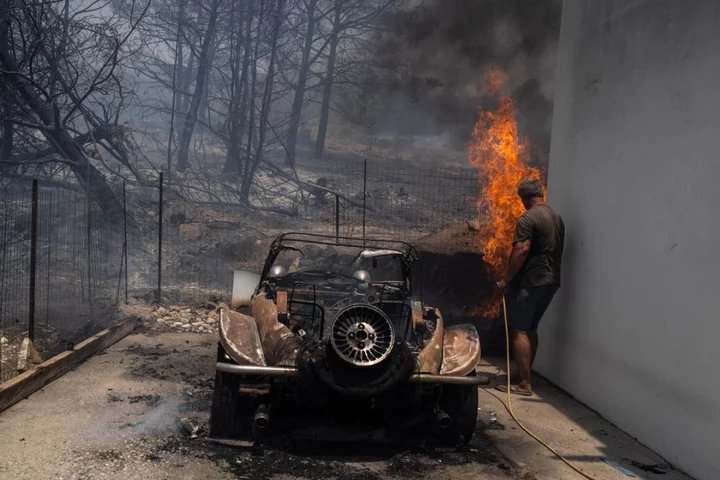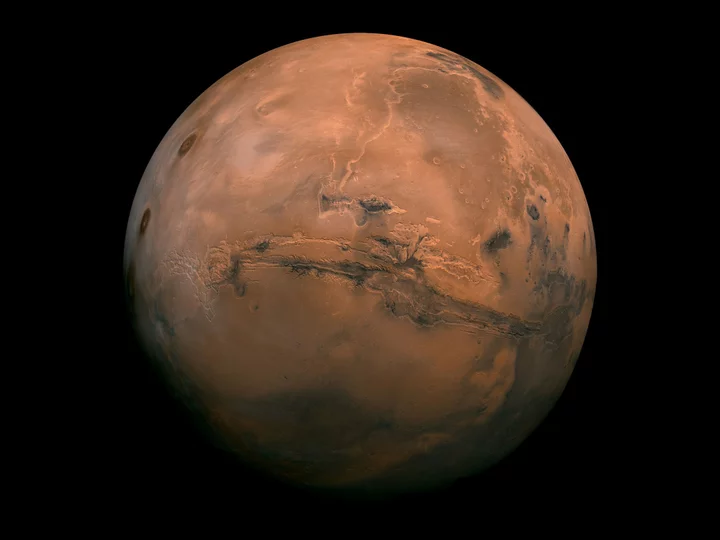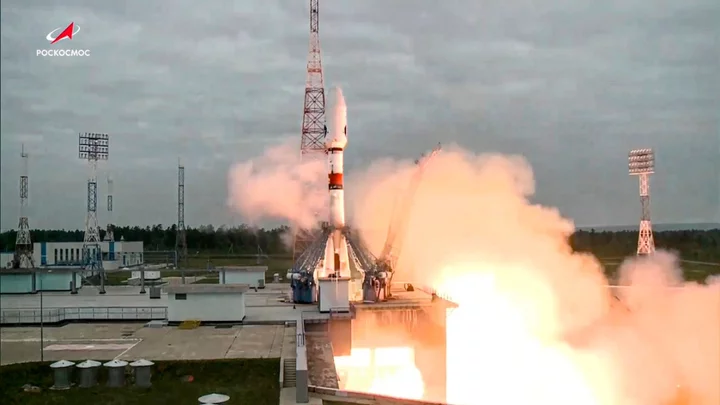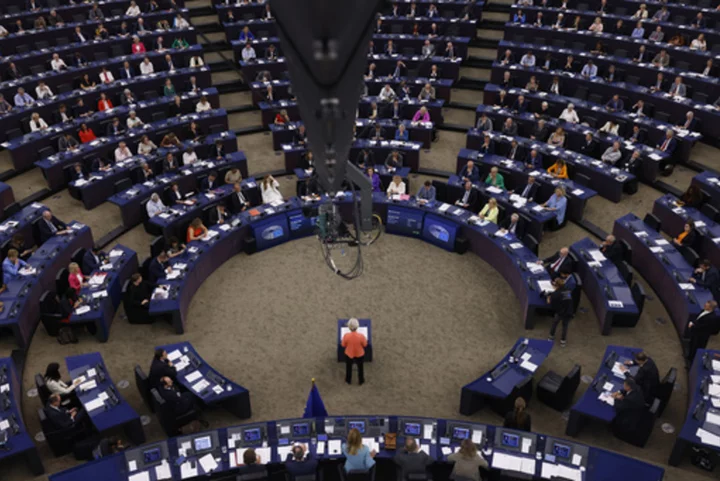Evacuations are set to continue in Greece as Corfu and Evia have become the latest Islands to issue orders while the country grapples with the devastating wildfires. The Greek fire service has said around 2,500 people have evacuated from Corfu so far. Thousands of people have also been forced to leave their homes and hotels - with those in Santa, Megoula, Porta, Palia Perithia and Sinies being told to evacuate to Kassiopi. A spokesperson from the Met Office told The Independent: “Temperatures on Rhodes are likely to peak on Wednesday, and could be close to 39C in some spots. Temperatures are then expected to move back towards average for the time of year later in the week, likely around 30C. “However, windy conditions could impact efforts this week. There are some northwesterly winds today, with these likely to ease on Tuesday and Wednesday. “However, a return of windy weather is possible later in the week, albeit accompanied by that drop in temperatures,” the Met Office added. What will the weather be like this week in Greece? According to the Met Office website, the temperature in Rhodes will be as follows: Monday 24 July - Highest temperature: 36C and Lowest: 31C Tuesday 25 July - Highest: 37C and Lowest: 28C Wednesday 26 July - Highest: 39C and Lowest: 27C Thursday 27 July - Highest: 36C and Lowest: 23C Friday 28 July - Highest: 34C and Lowest: 24C Saturday 29 July - Highest: 32C and Lowest: 22C Sunday 30 July- Highest: 33C and Lowest: 24C How long will the wildfires last? The climate crisis is increasing the risk of larger, more intense and erratic wildfires around the world due to hotter and drier conditions. Other factors also play a role including soil moisture levels, and the presence of vegetation which acts as fuel for fires. “It’s important to note that these wildfires are happening in environments that are naturally prone to fire during hot and dry summers, with vegetation that is highly adapted to live with fire”, Dr Matthew Jones, NERC Independent Research Fellow, Tyndall Centre for Climate Change Research, School of Environmental Sciences, UEA, said in a statement. Dr Jones added that under climate change and frequent changes to weather conditions across the globe, fires are more likely to break out and “also burn so intensely and synchronously across the Mediterranean.” “The Mediterranean has seen a dramatic increase in the frequency of the hot-dry conditions that were considered extreme at the end of the last century, and these increases are expected to accelerate for each added degree of warming in future,” he noted. According to the Joint Research Centre, last year was the second-worst wildfire season in Europe. In 2022, damages exceeded those of 2021, as per data from the EFFIS - an advanced report on Forest Fires in Europe, the Middle East and North Africa. The EFFIS looked at fires in 45 countries and found that these places suffered from 16,941 fires that burnt 1,624,381 hectares. Looking at just European countries, July 2022 was the month when the most significant proportion of damage occurred in Spain, Portugal, France, Italy and Greece. According to Safer Scotland’s Wildfire Operational Guidance, a wildfire can burn for a “period of time” and this is heavily dependent on the landscape, which contributes to how fast the fire might move. The “behaviour” of the wildfire depends on the following factors: the area, its combustibility and arrangement, the arrangement of the area, the weather and time. Dependent on stable or unstable weather conditions the Wildfire Operational Guidance said time “can have a positive or negative effect on fire development throughout the day and this will bring both advantage and disadvantage to firefighting operations.” Space is another important factor as the area in which the fire is burning brings changes to the shape of the fire, altering the fire’s alignment. For example, as fire changes its location and moves across the area “topographical and climactic conditions will work for and against the first altering its intensity and speed.” What impacts does fuel have on wildfires? When a wildfire occurs, the main source of fuel is vegetation. This type of fuel, its size and the way the vegetation is arranged across the landscape will affect the way the fire burns. The Wildfire Operational Guidance has said the size and shape of the fuel are important especially “in regard to their ease of ignition. Smaller fuels, referred to as ‘fine fuels’, are more receptive to fire, while larger or more coarse fuel types generally rely on their interaction with fires in finer fuels before they will ignite.” Fine fuels are considered to be those with a diameter of up to 6mm, this includes grass, small stems and the leaves of low-lying shrubs. These fine fuels can also be found in large quantities in plants - such as needles on conifer trees. “Fuels that are over 6mm in diameter are described as ‘coarse fuel’ and include twigs, branches, and tree trunks,” the guidance has said. Fine fuels can affect the intensity of the fire, the rate and motion of the fire, the flame length, the fire activity and increased ignitions caused by spot fires. When asked about how long the wildfires might last in Greece, Jim Dale, founder and senior Meteorlogical Consultant at the British Weather Services told The Independent: “For as long as there is ‘fuel’ as in combustible brush. The wind is the enemy as far as people and infrastructure are concerned; there is no sign of rain. “The two main fire zones of Rhodes and Corfu will almost certainly be added to as the Mediterranean basin continues to bake with record and near-record temperatures.” Read More Greek fires ‘big warning’ for tourists to Mediterranean, says climate expert Greece fires – live: Corfu evacuations begin as tourists fleeing Rhodes inferno spend second night in airport Greece wildfires: Rhodes tourists sleep on airport floor awaiting evacuation
Evacuations are set to continue in Greece as Corfu and Evia have become the latest Islands to issue orders while the country grapples with the devastating wildfires. The Greek fire service has said around 2,500 people have evacuated from Corfu so far.
Thousands of people have also been forced to leave their homes and hotels - with those in Santa, Megoula, Porta, Palia Perithia and Sinies being told to evacuate to Kassiopi.
A spokesperson from the Met Office told The Independent: “Temperatures on Rhodes are likely to peak on Wednesday, and could be close to 39C in some spots. Temperatures are then expected to move back towards average for the time of year later in the week, likely around 30C.
“However, windy conditions could impact efforts this week. There are some northwesterly winds today, with these likely to ease on Tuesday and Wednesday.
“However, a return of windy weather is possible later in the week, albeit accompanied by that drop in temperatures,” the Met Office added.
What will the weather be like this week in Greece?
According to the Met Office website, the temperature in Rhodes will be as follows:
Monday 24 July - Highest temperature: 36C and Lowest: 31C
Tuesday 25 July - Highest: 37C and Lowest: 28C
Wednesday 26 July - Highest: 39C and Lowest: 27C
Thursday 27 July - Highest: 36C and Lowest: 23C
Friday 28 July - Highest: 34C and Lowest: 24C
Saturday 29 July - Highest: 32C and Lowest: 22C
Sunday 30 July- Highest: 33C and Lowest: 24C
How long will the wildfires last?
The climate crisis is increasing the risk of larger, more intense and erratic wildfires around the world due to hotter and drier conditions. Other factors also play a role including soil moisture levels, and the presence of vegetation which acts as fuel for fires.
“It’s important to note that these wildfires are happening in environments that are naturally prone to fire during hot and dry summers, with vegetation that is highly adapted to live with fire”, Dr Matthew Jones, NERC Independent Research Fellow, Tyndall Centre for Climate Change Research, School of Environmental Sciences, UEA, said in a statement.
Dr Jones added that under climate change and frequent changes to weather conditions across the globe, fires are more likely to break out and “also burn so intensely and synchronously across the Mediterranean.”
“The Mediterranean has seen a dramatic increase in the frequency of the hot-dry conditions that were considered extreme at the end of the last century, and these increases are expected to accelerate for each added degree of warming in future,” he noted.
According to the Joint Research Centre, last year was the second-worst wildfire season in Europe. In 2022, damages exceeded those of 2021, as per data from the EFFIS - an advanced report on Forest Fires in Europe, the Middle East and North Africa.
The EFFIS looked at fires in 45 countries and found that these places suffered from 16,941 fires that burnt 1,624,381 hectares.
Looking at just European countries, July 2022 was the month when the most significant proportion of damage occurred in Spain, Portugal, France, Italy and Greece.
According to Safer Scotland’s Wildfire Operational Guidance, a wildfire can burn for a “period of time” and this is heavily dependent on the landscape, which contributes to how fast the fire might move.
The “behaviour” of the wildfire depends on the following factors: the area, its combustibility and arrangement, the arrangement of the area, the weather and time.
Dependent on stable or unstable weather conditions the Wildfire Operational Guidance said time “can have a positive or negative effect on fire development throughout the day and this will bring both advantage and disadvantage to firefighting operations.”
Space is another important factor as the area in which the fire is burning brings changes to the shape of the fire, altering the fire’s alignment. For example, as fire changes its location and moves across the area “topographical and climactic conditions will work for and against the first altering its intensity and speed.”
What impacts does fuel have on wildfires?
When a wildfire occurs, the main source of fuel is vegetation. This type of fuel, its size and the way the vegetation is arranged across the landscape will affect the way the fire burns.
The Wildfire Operational Guidance has said the size and shape of the fuel are important especially “in regard to their ease of ignition. Smaller fuels, referred to as ‘fine fuels’, are more receptive to fire, while larger or more coarse fuel types generally rely on their interaction with fires in finer fuels before they will ignite.”
Fine fuels are considered to be those with a diameter of up to 6mm, this includes grass, small stems and the leaves of low-lying shrubs. These fine fuels can also be found in large quantities in plants - such as needles on conifer trees.
“Fuels that are over 6mm in diameter are described as ‘coarse fuel’ and include twigs, branches, and tree trunks,” the guidance has said.
Fine fuels can affect the intensity of the fire, the rate and motion of the fire, the flame length, the fire activity and increased ignitions caused by spot fires.
When asked about how long the wildfires might last in Greece, Jim Dale, founder and senior Meteorlogical Consultant at the British Weather Services told The Independent: “For as long as there is ‘fuel’ as in combustible brush. The wind is the enemy as far as people and infrastructure are concerned; there is no sign of rain.
“The two main fire zones of Rhodes and Corfu will almost certainly be added to as the Mediterranean basin continues to bake with record and near-record temperatures.”
Read More
Greek fires ‘big warning’ for tourists to Mediterranean, says climate expert
Greece fires – live: Corfu evacuations begin as tourists fleeing Rhodes inferno spend second night in airport
Greece wildfires: Rhodes tourists sleep on airport floor awaiting evacuation









